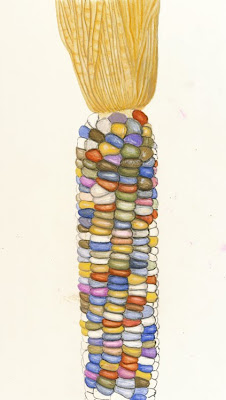I received a lovely email today and with the writer's permission I will share with you. Margaret and I "met" as students during both of the Cornell drawing and watercolor online courses. In our mixed and lively discussions, she mentioned how she dug her own earths. Of course, I just had to have some, and in fact, her offer came before my request.
Here is Margaret's watercolor using only her North Carolina earths that I ground and tubed up.

And here is her letter:
Hey John,
I am going to try and attach a scan my 1st painting using only the "Earths"
Meantime, there is a little bit of story behind the ochre-ish PB.
On the way to my parents house in N. Ga. I take a back road and in a curve just over a hill is a gas station of the kind I suspect is indigenous only to our region and southward. When it was open, there were boiled peanuts when in season, so the place was often shrouded in smoke. Through the smoke, you could see cars in various stages of assembly, or dis-assembly. A rack of dented aluminum canoes for rent and a goat wandering about freely don't even begin to complete the picture.
Behind and beside this is the bank of beautiful yellow earth.
I have eyed that bank for ages, but never stopped. The gas station/store was just too complex to take in.
Last year the store closed. Everything is there except the goat, but it is all still.
It seemed like the only thing going on there was gravity, so on one trip home I whipped the car over, got some Dollar General bags out from under the debris in the backseat and went to clawing earth out of the bank. A dog came along, but I didn't pay much attention. I was engrossed in finding color and in appearing non-chalant when cars passed. When I did finally look up, there was an enormous, big bearded man standing in the door of the store. His arms were crossed and his demeanor did not appear to be friendly.
"Hi," I said.
No reply.
"I'm just getting some dirt."
No reply.
"I'm gonna make some paint."
No reply. Just then the dog almost got hit by a car.
"That your dog?"
Head shake.
"You know whose it is?"
Another head shake.
"I think it might get hit, maybe I should find it's home."
Head nod. Demeanor unchanged.
" Well, is it OK if I take this dirt?"
Head nod.
"Well I guess I'll take the dog, too."
Head nod.
"Thank, you"
No reply.
He was still standing in the door with his arms crossed as I packed in the dog, earth and headed down the road.
The dog was reconnected with its owners at next establishment.
A brief splinter in geologic time.
The painting evolved with experience, and skill with the paint will continue to evolve, I hope.
I learned to be lighter, worked it right to left and you can see the change. The right is much too heavy.
I actually began to enjoy the limited palette. It's a little like working with ink washes, but w/subtle colors and different behavior. I love the little mica sparkles in the wash.
I am thinking toward doing another an adding just a little bit of wash from my commercial paints.
Fun and challenging. I looked up egg tempera recipes and find myself tempted.
Waiting for a large slot of uninterrupted time.
Thanks
MO
















































